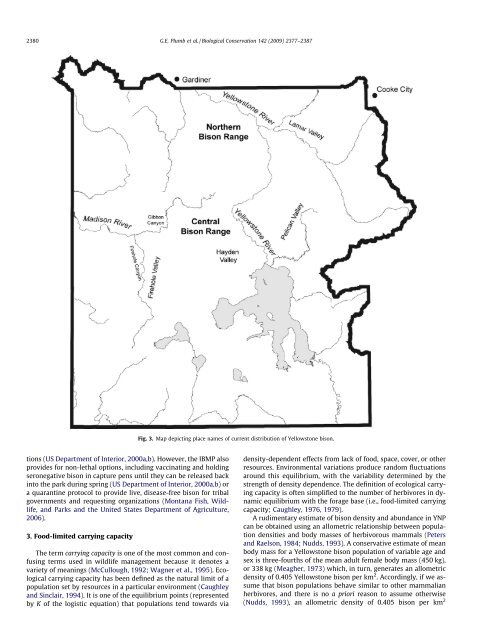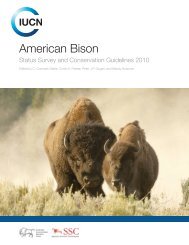Carrying capacity, migration, and dispersal in ... - ResearchGate
Carrying capacity, migration, and dispersal in ... - ResearchGate
Carrying capacity, migration, and dispersal in ... - ResearchGate
Create successful ePaper yourself
Turn your PDF publications into a flip-book with our unique Google optimized e-Paper software.
2380 G.E. Plumb et al. / Biological Conservation 142 (2009) 2377–2387<br />
tions (US Department of Interior, 2000a,b). However, the IBMP also<br />
provides for non-lethal options, <strong>in</strong>clud<strong>in</strong>g vacc<strong>in</strong>at<strong>in</strong>g <strong>and</strong> hold<strong>in</strong>g<br />
seronegative bison <strong>in</strong> capture pens until they can be released back<br />
<strong>in</strong>to the park dur<strong>in</strong>g spr<strong>in</strong>g (US Department of Interior, 2000a,b) or<br />
a quarant<strong>in</strong>e protocol to provide live, disease-free bison for tribal<br />
governments <strong>and</strong> request<strong>in</strong>g organizations (Montana Fish, Wildlife,<br />
<strong>and</strong> Parks <strong>and</strong> the United States Department of Agriculture,<br />
2006).<br />
3. Food-limited carry<strong>in</strong>g <strong>capacity</strong><br />
The term carry<strong>in</strong>g <strong>capacity</strong> is one of the most common <strong>and</strong> confus<strong>in</strong>g<br />
terms used <strong>in</strong> wildlife management because it denotes a<br />
variety of mean<strong>in</strong>gs (McCullough, 1992; Wagner et al., 1995). Ecological<br />
carry<strong>in</strong>g <strong>capacity</strong> has been def<strong>in</strong>ed as the natural limit of a<br />
population set by resources <strong>in</strong> a particular environment (Caughley<br />
<strong>and</strong> S<strong>in</strong>clair, 1994). It is one of the equilibrium po<strong>in</strong>ts (represented<br />
by K of the logistic equation) that populations tend towards via<br />
Fig. 3. Map depict<strong>in</strong>g place names of current distribution of Yellowstone bison.<br />
density-dependent effects from lack of food, space, cover, or other<br />
resources. Environmental variations produce r<strong>and</strong>om fluctuations<br />
around this equilibrium, with the variability determ<strong>in</strong>ed by the<br />
strength of density dependence. The def<strong>in</strong>ition of ecological carry<strong>in</strong>g<br />
<strong>capacity</strong> is often simplified to the number of herbivores <strong>in</strong> dynamic<br />
equilibrium with the forage base (i.e., food-limited carry<strong>in</strong>g<br />
<strong>capacity</strong>; Caughley, 1976, 1979).<br />
A rudimentary estimate of bison density <strong>and</strong> abundance <strong>in</strong> YNP<br />
can be obta<strong>in</strong>ed us<strong>in</strong>g an allometric relationship between population<br />
densities <strong>and</strong> body masses of herbivorous mammals (Peters<br />
<strong>and</strong> Raelson, 1984; Nudds, 1993). A conservative estimate of mean<br />
body mass for a Yellowstone bison population of variable age <strong>and</strong><br />
sex is three-fourths of the mean adult female body mass (450 kg),<br />
or 338 kg (Meagher, 1973) which, <strong>in</strong> turn, generates an allometric<br />
density of 0.405 Yellowstone bison per km 2 . Accord<strong>in</strong>gly, if we assume<br />
that bison populations behave similar to other mammalian<br />
herbivores, <strong>and</strong> there is no a priori reason to assume otherwise<br />
(Nudds, 1993), an allometric density of 0.405 bison per km 2










